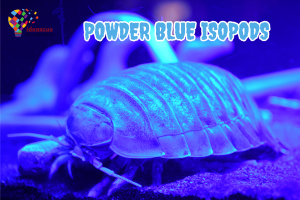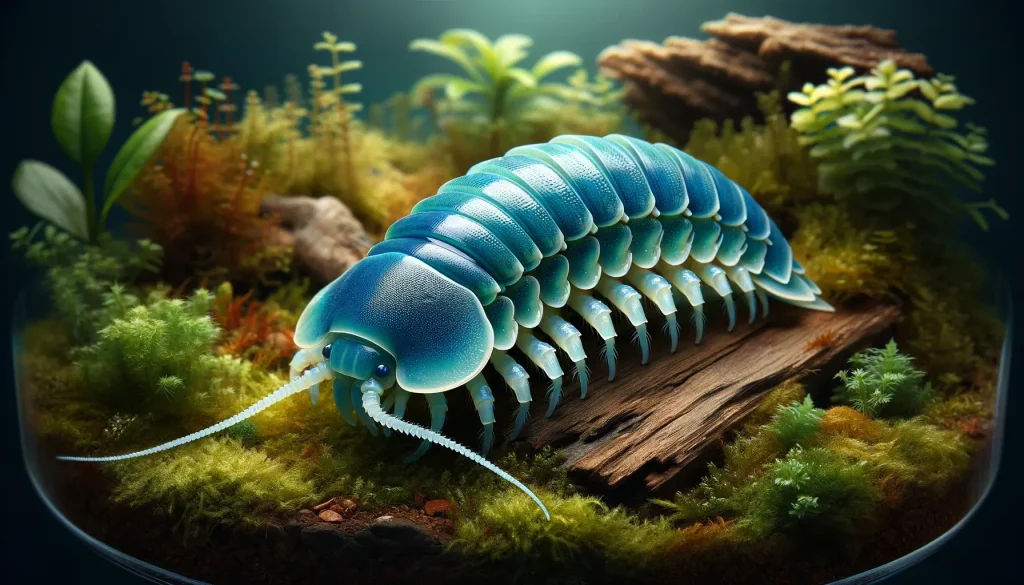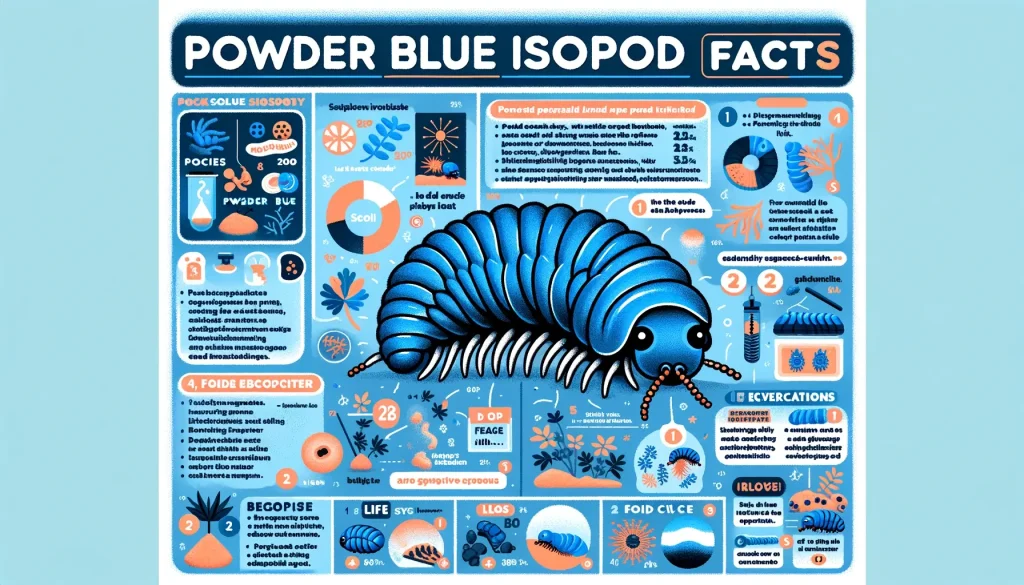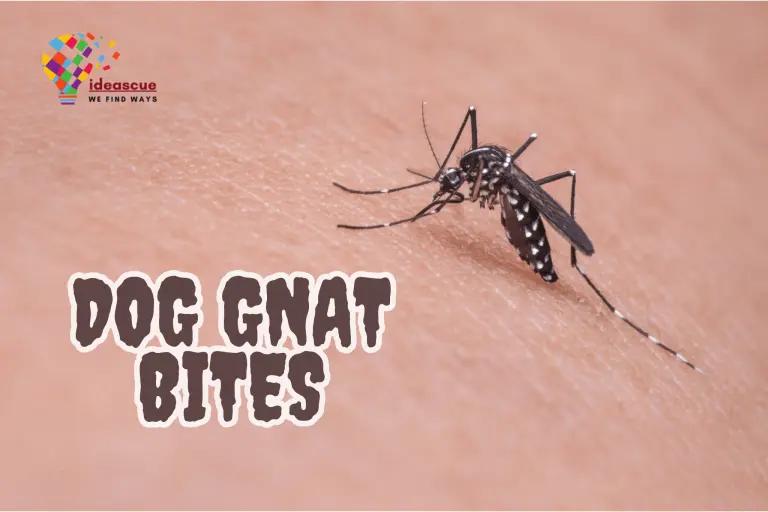What Is Powder Blue Isopods?
Intro:
Powder blue isopods are small, intriguing creatures that are becoming increasingly popular in the pet world. They are known for their unique color and easy care requirements. These isopods are not just for show; they play a vital role in bioactive terrariums, helping to keep the environment clean and balanced.
Their versatility makes them a great choice for both beginners and experienced pet owners. In this article, we will explore everything about powder blue isopods, from their appearance to how to care for them. Whether you’re a curious beginner or a seasoned enthusiast, you’ll find useful and engaging information about these fascinating invertebrates.

Powder blue isopods, scientifically known as Porcellionides pruinosus, are a species of land isopods. Originating from Europe, they have gained popularity in the pet industry due to their distinctive colour and ease of care. These isopods serve a dual purpose: as a clean-up crew in terrariums and as nutritious feed for reptiles and amphibians. Their adaptability to various environments makes them an ideal choice for both purposes.
What Do Powder Blue Isopods Look Like?
Powder blue isopods are notable for their striking, powdery blue hue, which distinguishes them from other isopod varieties. Adults typically measure around 0.5 to 0.8 inches in length. They have a convex, segmented body with seven pairs of legs and prominent antennae. Their coloration not only makes them visually appealing but also provides a great contrast in terrariums, enhancing the aesthetic value of your setup.

Pros and Cons of Powder Blue Isopods:
Powder blue isopods are easy to care for and breed, making them great for beginners. They work well as a clean-up crew in terrariums, eating decaying matter and thus keeping the environment clean. Their unique blue color adds a beautiful contrast to terrarium setups.
However, these isopods can overpopulate quickly if not properly managed. They also need specific humidity and temperature conditions, which might require extra attention. Their dietary needs are more limited compared to some other isopod species, which might restrict their use in varied terrarium environments.
Pros:
- Easy to care for and breed, making them suitable for beginners.
- Serve as an effective clean-up crew in terrariums, consuming decaying matter.
- Aesthetically pleasing due to their unique coloration.
Cons:
- Require specific humidity and temperature conditions.
- Can overpopulate in contained environments if not managed.
- Limited dietary variety compared to some other isopod species.
Powder Blue Isopod Facts:
Habitat:
Powder blue isopods naturally live in damp and dark places. They often hide under rocks or decaying wood in their natural environment. These areas provide the moisture and protection they need.
Isolated and/or Bioactive:
Powder blue isopods excel in both isolated setups and bioactive terrariums. In isolated environments, they live in their own space, thriving with minimal care. In bioactive terrariums, they contribute to the ecosystem, breaking down waste and promoting a healthy environment for other inhabitants. This versatility makes them a top choice for different types of terrarium setups.
Diet:
Powder blue isopods primarily feed on decaying plant material. This includes leaf litter, rotting wood, and occasional vegetables. Adding variety to their diet with fruits and small amounts of animal protein, like fish flakes, promotes their health and growth.
A balanced diet is key for these isopods. It ensures they stay healthy and active. Remember, too much fresh food can mold quickly, so it’s important to monitor and adjust their food supply as needed.
Temperament:
Powder blue isopods are known for their docile nature. They are non-aggressive and tend to be skittish, often hiding when disturbed. This makes them easy to handle and a good choice for those new to caring for invertebrates.
In their natural habitat, these isopods avoid confrontation and prefer to retreat. Their calm demeanor is one of the reasons they are popular in terrarium setups. They peacefully coexist with other species, making them an excellent addition to bioactive environments.
Lifespan:
Powder blue isopods typically live for 2 to 3 years. This lifespan is contingent on their living conditions, including proper care and environment.
Ensuring they have the right habitat and diet plays a crucial role in their longevity. Regular maintenance of their environment helps in maximizing their lifespan.
Breeding:
Powder blue isopods breed easily, making them great for beginners. They reproduce quickly, so a small group can become a large colony in a short time.
Providing the right conditions, including adequate food and a moist environment, encourages their breeding. Regular monitoring of the colony’s size helps to manage its population effectively.
Baby Blue vs Powder Blue:
Baby blue is a soft, pastel shade reminiscent of the clear sky, often used in nurseries and baby clothing for its calming effect.
Powder blue, in contrast, has a slightly grey or dusty tone, giving it a more earthy appearance, and is popular in fashion and home decor for its neutral yet subtly vibrant quality.
While both colors are tranquil, baby blue is typically associated with serenity, whereas powder blue offers a sophisticated, down-to-earth vibe.
Powder Blue Isopods Humidity and Temperature:
Maintaining the right humidity (around 70-80%) and temperature (between 68-78°F) is crucial for powder blue isopods. They thrive in moist environments but not overly wet, as excess moisture can lead to health issues. A balance between damp and dry areas in their habitat is essential for their wellbeing.

Where To Find Powder Blue Isopods:
Finding powder blue isopods is quite straightforward. You can locate them at local pet stores specializing in exotic species or through online vendors that offer a variety of terrarium creatures. Checking online forums and communities dedicated to invertebrate pets can also lead you to reputable breeders.
Additionally, exotic pet expos and shows often feature these isopods. These events are great for meeting breeders and learning more about the care and maintenance of powder blue isopods directly from experts. Remember to choose a source that ensures healthy and ethically-bred isopods.
Powder Blue Isopod Care:
Caring for powder blue isopods involves setting up a suitable environment with a balance of moisture, providing a diet rich in organic matter, and ensuring cleanliness. Regularly check for mold and maintain appropriate temperature and humidity levels. They are low-maintenance, making them an excellent choice for beginners.
What Do Powder Blue Isopods Eat?
Their diet consists mainly of decaying plant matter, such as leaf litter, rotting wood, and vegetables. Occasionally, they can also consume fruits and animal protein like fish flakes. A varied diet ensures optimal health and vitality, aiding in their growth and reproduction.
Tank Requirements:
A simple setup with a mix of soil and coconut fiber works well, along with hiding places like bark or hollow logs. A small water dish or moistened sponge can help maintain humidity. Avoid overcrowding, as it can lead to stress and health issues among the isopods.
Best Tankmates For Powder Blue Isopods:
They coexist well with non-aggressive reptiles, amphibians, and other invertebrates. Avoid pairing them with species that may view them as prey. In a bioactive setup, they can be combined with other detritivores to create a self-cleaning ecosystem.
FAQs
Conclusion:
In summary, powder blue isopods are both a delight to watch and a practical addition to terrariums. Their unique color and easy care make them ideal for hobbyists of all levels. With their ability to clean up waste and provide nutrition for other pets, they are truly versatile.
Adopting these isopods brings a blend of beauty and functionality to your setup. Remember, their well-being hinges on proper care and environment. By meeting these needs, you’ll enjoy the fascinating world of powder blue isopods to the fullest.






